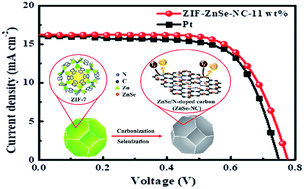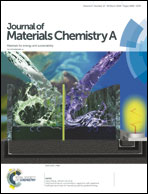A zeolitic imidazolate framework-derived ZnSe/N-doped carbon cube hybrid electrocatalyst as the counter electrode for dye-sensitized solar cells†
Abstract
Owing to its excellent electrocatalytic performance, zinc selenide (ZnSe) is regarded as a promising counter electrode (CE) material for dye-sensitized solar cells (DSSCs). In this study, a zeolitic imidazolate framework (ZIF-7) derived ZnSe nanocomposite is introduced as the electrocatalyst for the CE in a DSSC. First, ZIF-7 powder was subjected to carbonization and then transformed into ZIF-7/N-doped carbon (ZIF-NC). To further increase the electrocatalytic ability of the materials, ZIF-7-NC was selenized and transformed into a ZIF-7 derived ZnSe/N-doped carbon cube (ZIF-ZnSe-NC). After optimizing the weight percentage of the ZIF-ZnSe-NC film, the DSSCs with a CE of ZIF-ZnSe-NC-11 wt% rendered a photovoltaic conversion efficiency (η) of 8.69 ± 0.13%, which is higher than that of the cell with a Pt CE (8.26 ± 0.02%). This study concludes that the CE based on the ZIF-ZnSe-NC is a prospective substitute for Pt and could provide new opportunities for advancing high-efficiency DSSCs under in-house conditions with dim light illumination.



 Please wait while we load your content...
Please wait while we load your content...